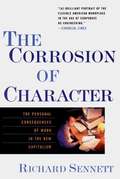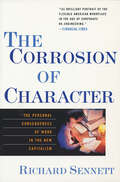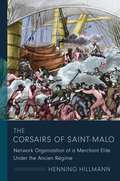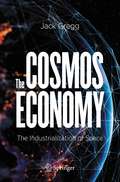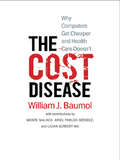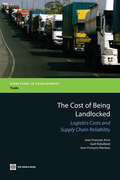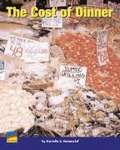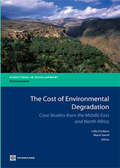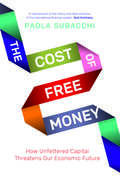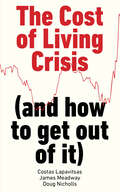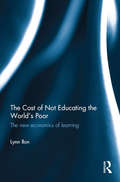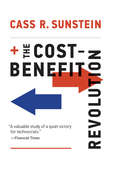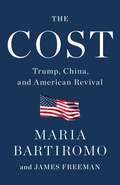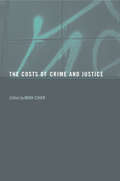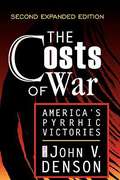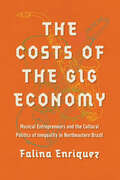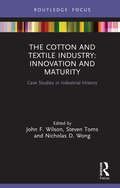- Table View
- List View
The Corporatization of the Business School: Minerva Meets the Market
by Dan Kärreman Mats Benner Tony HuzzardWith business schools becoming increasingly market-driven, questionable trends have emerged, such as the conflation of academic and corporate management, and the notion that academics and students are market players, who respond rationally to market signals. Using individual studies from leading scholars in a variety of disciplines and countries, this book identifies the global pressures behind these trends. It focuses on the debates surrounded the commercialization of business schools, and the rise of different methods of measuring their success. In their unique approach, the authors and editors discuss the impact of the confrontation between the timeless values embodied by Minerva, the Roman goddess of Wisdom, and the hard realities of competition and corporatization in modern society. This book will be compelling reading for students and academics in critical management studies, organizational studies, public management and higher education, as well as for stakeholders in academia and educational policy.
The Correspondence of Sir Walter Scott and Charles Robert Maturim (Routledge Revivals)
by Fannie E. Ratchford William H. McCarthyOriginally published in 1937, The Correspondence of Sir Walter Scott and Charles Robert Maturin contains twenty-two letters presenting a penetrating and vivid self-portrait of Sir Walter Scott. Scott's patronage of Maturin, this impecunious Irish author, giving him wise advice, lending encouragement in his work and at times badly needed financial assistance, extended over a period of twelve years to the time of Maturin's death, and his kind subsequent letters, written to Maturin's family, in the midst of his own great financial troubles, bring to a fitting close this single unit in Scott's rich social life. Since the two men never met, the whole relationship was built up through thier literary work and their letters to each other, displayed in this volume.
The Corrosion of Character: The Personal Consequences of Work in the New Capitalism
by Richard SennettIn The Corrosion of Character, Richard Sennett draws on interviews with dismissed IBM executives, bakers, a bartender turned advertising executive, and many others to call into question the terms of our new economy. Sennett explores the contemporary scene characterized by Enrico's son, Rico, whose life is more materially successful, yet whose work lacks long-term commitments or loyalties.
The Corrosion of Character: The Personal Consequences of Work in the New Capitalism
by Richard SennettA Business Week Best Book of the Year.... "A devastating and wholly necessary book."--Studs Terkel, author of Working In The Corrosion of Character, Richard Sennett, "among the country's most distinguished thinkers . . . has concentrated into 176 pages a profoundly affecting argument" (Business Week) that draws on interviews with dismissed IBM executives, bakers, a bartender turned advertising executive, and many others to call into question the terms of our new economy. In his 1972 classic, The Hidden Injuries of Class (written with Jonathan Cobb), Sennett interviewed a man he called Enrico, a hardworking janitor whose life was structured by a union pay schedule and given meaning by his sacrifices for the future. In this new book-a #1 bestseller in Germany-Sennett explores the contemporary scene characterized by Enrico's son, Rico, whose life is more materially successful, yet whose work lacks long-term commitments or loyalties. Distinguished by Sennett's "combination of broad historical and literary learning and a reporter's willingness to walk into a store or factory [and] strike up a conversation" (New York Times Book Review), this book "challenges the reader to decide whether the flexibility of modern capitalism . . . is merely a fresh form of oppression" (Publishers Weekly, starred review). Praise for The Corrosion of Character: "A benchmark for our time."--Daniel Bell "[A]n incredibly insightful book."--William Julius Wilson "[A] remarkable synthesis of acute empirical observation and serious moral reflection."--Richard Rorty "[Sennett] offers abundant fresh insights . . . illuminated by his concern with people's struggle to give meaning to their lives."--[Memphis] Commercial Appeal
The Corsairs of Saint-Malo: Network Organization of a Merchant Elite Under the Ancien Régime (The Middle Range Series)
by Henning HillmannWestern Europe rose in global power during the early modern period as overseas expansion opened new trade routes. At the same time, intense rivalries pitted European states against one another in recurrent wars. Henning Hillmann examines the merchant community of Saint-Malo, Brittany, a key port in the French Atlantic economy, to shed light on the local networks that linked commerce and conflict in early modern Europe.Hillmann traces the development of Saint-Malo and the social structure of its merchant elite from the 1680s through the onset of the French Revolution. He pinpoints the role of privateering, showing how it enabled local merchant communities to secure their hold on established trades, seize new opportunities, and withstand the threats of armed conflict. In wartime, rulers commissioned ship-owning traders to fit out vessels as corsairs to raid enemy shipping. Within a mercantilist worldview, this state-sanctioned private war at sea aligned the interests of local elites and the royal government. Locally, within Saint-Malo, the partnerships that merchant elites formed in their privateering ventures gave rise to a cohesive network that held their community together amid outside conflicts. Combining rich descriptions of privateering campaigns with quantitative network analysis of partnership ties over more than a century, The Corsairs of Saint-Malo offers a new understanding of the local organizational foundations of early modern capitalist development.
The Cosmos Economy: The Industrialization of Space
by Jack GreggIf man’s next big step is to live and work in space, then what will everyone do out there that is so different from what we are now doing here on Earth? As the future of space comes into focus it is clear that profit and power are the core elements of the new space economy. This entertaining and informative book looks at human settlement in space as a mainstream business opportunity for investors, entrepreneurs and far-sighted individuals seeking to secure their place in the innovative commercial space sector. Dr. Jack Gregg presents a unique 5-phase development roadmap that shows how space will grow from a frontier economy to a mature integrated market. Written in simple, non-technical language, this book answers such questions as:• What is the new industrial space economy?• What are the challenges and roadblocks on the way to a robust space economy?• How will the rapid growth of the new space economy impact commerce back on Earth?• How can one best invest in profitable space-related enterprises? The Cosmos Economy is for readers who hope to be better equipped and more informed about the new space economy; and Investors, entrepreneurs, and futurists who wants to learn how to take part in the business opportunities of the new high frontier of commercial space.
The Cost Disease
by William J. BaumolThe exploding cost of health care in the United States is a source of widespread alarm. Similarly, the upward spiral of college tuition fees is cause for serious concern. In this concise and illuminating book, the well-known economist William J. Baumol explores the causes of these seemingly intractable problems and offers a surprisingly simple explanation. Baumol identifies the "cost disease" as a major source of rapidly rising costs in service sectors of the economy. Once we understand that disease, he explains, effective responses become apparent. Baumol presents his analysis with characteristic clarity, tracing the fast-rising prices of health care and education in the United States and other major industrial nations, then examining the underlying causes, which have to do with the nature of providing labor-intensive services. The news is good, Baumol reassures us, because the nature of the disease is such that society will be able to afford the rising costs.
The Cost of Accidents
by Guido CalabresiAccident law is currently under review throughout the United States, and indeed the world, as present systems prove increasingly inadequate to handle the mounting costs of automobile accidents. In this pioneering work, Guido Calabresi develops a framework for evaluating different systems of accident law. Defining the goal of accident law as the maximum reduction of accident and accident avoidance costs that can be achieved fairly, he examines ten political and economic choices implied in various approaches to reducing these costs. Calabresi then considers two fundamental problems all systems of accident law must face: who should be held responsible for accident costs, and how should they be valued? He analyzes the fault-insurance system now widely used and finds it wanting on grounds both of cost reduction objectives and fairness. In conclusion, he discusses recent proposals for reform of the law, points out questions they raise, and ends by indicating the two he thinks most likely to prevail and the fundamental conflict between them."Calabresi's book is most significant for its first-rate combination of modern economic analysis and legal policy. The methodology and underlying principles extend far beyond the particular subject matter of accident law to many other legal areas that could benefit from economic analysis. In turn, some economic analyses may become the richer for the discussion in this book. It is truly one of those rare important volumes."-Gerald M Meier
The Cost of Bad Behavior
by Christine Porath Christine PearsonWhy incivility at work is a bigger problem than you suspect In an accessible and informative style, Pearson and Porath examine the toll that bad behavior can have on otherwise well-functioning companies. And they reveal strategies that successful organizations are using to stop incivility before it takes hold. Whether it's a standoffish coworker or an arrogant boss, incivility at the office doesn't just affect the moods of a few employees; it hurts an entire company. Consider these statistics: 12 percent of all employees say they've left jobs because they were treated badly. Fortune 1000 executives spend roughly seven weeks per year resolving employee conflicts. And an astonishing 95 percent of Americans say they've experienced rudeness at work. Christine Pearson and Christine Porath examine the devastating toll that bad behavior can have on otherwise well-functioning companies. Combining their own scientific research with stories from fields as diverse as criminology, education, and psychology, they show how to spot the roots of incivility, rip them out, and create a culture of respect. They urge managers to stop making excuses, set a zero-tolerance policy, and lead by example. Bestsellers like The No Asshole Rule and The Power of Nice have shown the hunger for more civility at work; now The Cost of Bad Behavior shows exactly what to do about it.
The Cost of Being Landlocked: Logistics, Costs, and Supply Chain Reliability
by Gaël Raballand Jean-François Marteau Jean-François Arvis'The Cost of Being Landlocked' proposes a new analytical framework to interpret and model the constraints faced by logistics chains on international trade corridors. The plight of landlocked developing countries (LLDCs) has naturally received special attention for decades, leading to a specific set of development priorities based upon the concept of dependence on the transit state. Therefore, the standard approach used to tackle the cost of being landlocked has been predominantly aimed at developing regional transport infrastructure and ensuring freedom of transit through regional conventions. But without sufficient attention given to the performance of logistics service delivery to traders, the standard approach is unable to address key bottleneck concerns and the factors that contribute to the cost of being landlocked. Consequently, the impact of massive investment on trade corridors could not materialize to its full extent. Based on extensive data collection in several regions of the world, this book argues that although landlocked developing countries do face high logistics costs, these costs are not a result of poor road infrastructure, since transport prices largely depend on trucking market structure and implementation of transit processes. This book suggests that high logistics costs in LLDCs are a result of low logistics reliability and predictability, which stem from rent-seeking and governance issues. 'The Cost of Being Landlocked' will serve as a useful guide for policy makers, supervisory authorities, and development agencies.
The Cost of Environmental Degradation
by Lelia Croitoru Maria SarrafHow much is a cleaner environment worth? For policy makers, that question used to go largely unanswered. Many economic activities cause environmental degradation, entailing real costs to the economy and to people's welfare. Knowing the extent of these costs is crucial for identifying a country's main environmental priorities and allocating appropriate funds for environmental protection. Over the past decade, the World Bank has initiated a systematic effort to measure the costs of environmental degradation in the Middle East and North Africa, shedding new light on their magnitude and on the need for policy changes. In many cases, these costs were found to be surprisingly large. 'The Cost of Environmental Degradation: Case Studies from the Middle East and North Africa' brings together the best case studies of this program and summarizes their policy impacts at the national and regional levels. The case studies quantify monetarily the annual damage due to environmental degradation and express these estimates as percentages of the countries' gross domestic product. The studies use the most recent environmental valuation methods to estimate the economic costs resulting from air pollution, water degradation, deforestation, and land degradation. Uniquely, the book dedicates a case study to value the costs of environmental degradation resulting from an oil spill and demolition waste in times of conflict. The studies then illuminate the concrete implications on policy, investments, and institutions for the respective nations. This book will be of interest to policy makers, nongovernmental organizations, and academic and research institutions.
The Cost of Free Money: How Unfettered Capital Threatens Our Economic Future
by Paola SubacchiA penetrating account of how unchecked capital mobility is damaging international cooperation, polarizing the economic landscape, and ultimately reshaping the global order When it comes to the afflictions of the global economy, almost everyone—and especially Donald Trump—is quick to point the finger of blame at the state of international trade. But what about unconstrained capital flows? Unfettered capital has resulted in a string of financial and economic crises that have left our political systems strained and dialogue corroded. The once perceived benefits of openness have been cast to the wayside and the cracks in the global order can no longer be ignored. Paola Subacchi argues that international cooperation and interdependence have become crippled. Regional restrictions will soon strengthen and a multipolar order will take shape, leading to a distinctly transformed economic landscape in which China challenges the dominance of the US dollar. Combining history, analysis, and prediction, this book provides penetrating insight into the challenges facing the international economic order.
The Cost of IT: The Complexity of Managing an IT Budget
by Robert D. Austin Richard L. Nolan Shannon O'Donnell"The Adventures of an IT Leader" invites readers to "walk in the shoes" of Jim Barton, the new CIO of the fictional IVK Corporation, as he spends a difficult year learning effective information technology leadership, sidestepping the pitfalls that make the CIO job the most volatile, high-turnover job in the business. This chapter joins Barton as he sits down with the IT department's financial guru to answer what he believes are straightforward questions about IT spending and contribution to the company's bottom line. He is surprised to discover that there are no simple answers. This chapter is excerpted from "The Adventures of an IT Leader."
The Cost of Living Crisis: (and how to get out of it)
by Costas Lapavitsas Doug Nicholls James MeadwayA myth-busting pamphlet that charts a course out of the current cost of living crisis, focusing on Britain's current economic situationWe are living through a cost of living crisis, with interest rate hikes and the prices of everyday consumables and energy bills sky-rocketing. Why is this happening?Sometimes we are told that wages are too high, or that the government has "printed" too much money or that events far away, such as the war in Ukraine, are solely to blame. The plain argument that high prices go together with high profits, falling wages, and weak production is often distorted and hidden by mainstream commentary in the media and elsewhere.This plain-speaking pamphlet tells it straight: the big businesses dominating production and distribution make huge profits out of high inflation, while working people lose out. It sets out factual evidence to illustrate that the source of record profits is the fall in real wages as inflation rises.A large part of the income of working people is being transferred directly into the profits of big business. The pamphlet shows that the deeper roots of the "cost of living crisis" lie in the very low investment and poor productivity growth for many years. The basic steps to resolving the crisis are simple: prices, especially of essentials, must be brought down, and wages, salaries, benefits, and pensions must be increased.
The Cost of Living Crisis: Temporality, Provisioning, and Austerity in a Northern English City
by Natalie WoodSet in the Northern English City of Leeds, in the midst of Liz Truss’ 49 days in office, what we are now calling The Cost of Living Crisis emerges as the most recent incantation of economic decline. Challenging the ease with which this phrase has become commonplace, this monograph provokes questions of when and for whom it became normal to discuss the cost of being alive.The Cost of Living Crisis is both new and not new. With a focus on how economic decline is temporally experienced, Wood explores how consumption habits find solidarity with the past, claim membership in the present and grasp at uncertain futures. With a concern for where agency lies, Wood ultimately asks us: How is it that people deal, engage and reclaim precarious futures in the shop? Drawing from research conducted in a food pantry – a food bank that simulates a shop – Wood takes up a concept of provisioning as embodied knowledge and cultivated competence defined by the normalisation of economic recession. However, amidst hopelessness, the food pantry also materialises everyday acts of hope, care and play, which, in turn, perhaps provoke a reimagination not just of what a food bank is but of what shopping could be.This book is applicable to scholars of temporality, political and economic anthropology, the anthropology of Britain, economic crisis and consumption.
The Cost of Not Educating the World's Poor: The new economics of learning
by Lynn IlonIn The Cost of Not Educating the World’s Poor, Lynn Ilon observes from her 30 years of travel and work in some 20 developing countries, how global instability, problems of environmental degradation, spread of global disease, migration and political instability are a cost of viewing the uneducated poor as separated from a networked of fast-growing global knowledge. This book shows how powerful global learning systems are rapidly forming and linking the rich world with the world of the poor and developing nations. Using a narrative voice interleaved with concise introductions to the underlying theories (economics, development, learning, technology and networks) it shows us how changing our ways of thinking can lead to new possibilities. The Cost of Not Educating the World’s Poor is based on an emerging theory of development economics and the author’s own vast experiences and stories. It also discusses, among other issues: International development and how it has evolved toward an emphasis on knowledge How networked human capital creates new potential for poorly resourced countries The formation of a global system of learning networks The digitization of knowledge How nations improve their well-being through knowledge and equity This inter-disciplinary assessment of international learning inequality and the methods to overcome it will appeal to researchers concerned with emerging concepts of global learning networks and their effects on development. It will also be of interest to students and policymakers studying national inequality, economics, and global development.
The Cost-Benefit Revolution (The\mit Press Ser.)
by Cass R. SunsteinWhy policies should be based on careful consideration of their costs and benefits rather than on intuition, popular opinion, interest groups, and anecdotes.Opinions on government policies vary widely. Some people feel passionately about the child obesity epidemic and support government regulation of sugary drinks. Others argue that people should be able to eat and drink whatever they like. Some people are alarmed about climate change and favor aggressive government intervention. Others don't feel the need for any sort of climate regulation. In The Cost-Benefit Revolution, Cass Sunstein argues our major disagreements really involve facts, not values. It follows that government policy should not be based on public opinion, intuitions, or pressure from interest groups, but on numbers—meaning careful consideration of costs and benefits. Will a policy save one life, or one thousand lives? Will it impose costs on consumers, and if so, will the costs be high or negligible? Will it hurt workers and small businesses, and, if so, precisely how much?As the Obama administration's “regulatory czar,” Sunstein knows his subject in both theory and practice. Drawing on behavioral economics and his well-known emphasis on “nudging,” he celebrates the cost-benefit revolution in policy making, tracing its defining moments in the Reagan, Clinton, and Obama administrations (and pondering its uncertain future in the Trump administration). He acknowledges that public officials often lack information about costs and benefits, and outlines state-of-the-art techniques for acquiring that information. Policies should make people's lives better. Quantitative cost-benefit analysis, Sunstein argues, is the best available method for making this happen—even if, in the future, new measures of human well-being, also explored in this book, may be better still.
The Cost: Trump, China, and American Revival
by Maria Bartiromo James FreemanThe world needs a strong America, and America needs an economic revival after the Coronavirus season of shutdowns. Can the playbook that resulted in the greatest job market in history put Americans back to work?From the first moments of his presidency, Donald J. Trump put US economic revival at the top of his agenda. Cutting red tape and slashing business tax rates made companies eager to locate in America again. A surge in corporate investment led to record numbers of US job openings. But there was also another force at work at the start of the Trump era, and it&’s impossible to provide a fair accounting of Trump&’s governance without noting the unique obstacles he&’s faced. The President&’s critics styled themselves &“The Resistance,&” as if they were confronting a tyrant at the head of an invading army rather than their duly elected President. Much of the media establishment regularly—and wrongly—accused him of betraying the country. Most disturbing was the resistance movement inside government, formed even before the 2016 election, which unleashed unprecedented surveillance against Donald Trump. The political and media warfare has never ended. Just as an impeachment case collapsed in the Senate earlier this year, the world was beginning to realize how large a threat the Chinese communist government had become—and what it had been hiding in Wuhan. The destruction caused by the coronavirus is the latest and greatest test for the Trump prosperity agenda. Once again the health and wealth of the world depend on US leadership for economic revival. This is the story of the man US voters chose to lead in 2016 and will soon consider to lead again.
The Costs of Crime and Justice
by Mark A. Cohen Mark A CohenIn The Costs of Crime and Justice, Mark Cohen presents a comprehensive view of the financial setbacks of criminal behaviour. Victims of crime might incur medical costs, lost wages and property damage; while for some crimes pain, suffering and reduced quality of life suffered by victims far exceeds any physical damage. The government also incurs costs as the provider of mental health services, police, courts and prisons.Cohen argues that understanding the costs of crime can lead to important insights and policy conclusions - both in terms of criminal justice policy but also in terms of other social ills that compete with crime for government funding. This book systematically discusses the numerous methodological approaches and tallies up what is known about the costs of crimeA must-read for anyone involved in public policy, The Costs of Crime and Justice consolidates the diverse research in this area but also makes one of the most valuable contributions to date to the study of the economics of criminal behavior.
The Costs of Crime and Justice
by Mark A. CohenThis book presents a comprehensive view of the financial and non-financial consequences of criminal behavior, crime prevention, and society’s response to crime. Crime costs are far-reaching including medical costs, lost wages, property damage and pain, suffering, and reduced quality of life to victims and the public at large; police, courts, and prisons; and offenders and their families who may suffer consequences incidental to any punishment they receive for committing crime. The book provides a comprehensive economic framework and overview of the empirical methodologies used to estimate costs of crime. It provides an assessment of what is known and where the gaps in knowledge are in understanding the costs and consequences of crime. Individual chapters focus on victims, governments, as well as the public at large. Separate chapters detail the various methodologies used to estimate crime costs, while two chapters are devoted to policy analysis – both cost-effectiveness and benefit-cost analysis. The second edition is completely updated and expanded since the first edition in 2005. All cost estimates have also been updated. In addition, due to a significant increase in the number of studies on the cost of crime, new chapters focus on the costs to offenders and their families; white-collar and corporate crime; and cost of crime estimates around the world. Understanding the costs of crime can lead to important insights and policy conclusions—both for criminal justice policy and other social ills that compete with crime for government funding. Thus, the target audience for this book includes criminologists and policy makers who are seeking to apply rigorous social science methods to assist in developing appropriate criminal justice policies. Note that the book is nontechnical and does not assume the reader is conversant in economics or statistics.
The Costs of Sovereign Default
by Eduardo Borensztein Ugo PanizzaA report from the International Monetary Fund.
The Costs of War: America's Pyrrhic Victories (2nd expanded edition)
by John V. DensonBrings together essays piercing the veils of myth and propaganda to reveal the true costs of war, with special emphasis on loss of freedom to American citizens.
The Costs of the Gig Economy: Musical Entrepreneurs and the Cultural Politics of Inequality in Northeastern Brazil
by Falina EnriquezInstitutions in Recife, Brazil, have restructured subsidies in favor of encouraging musicians to become more entrepreneurial. Falina Enriquez explores how contemporary and traditional musicians in the fabled musical city have negotiated these intensified neoliberal cultural policies and economic uncertainties. Drawing on years of fieldwork, Enriquez shows how forcing artists to adopt “neutral” market solutions reinforces, and generates, overlapping racial and class-based inequalities. Lacking the social and financial resources of their middle-class peers, working-class musicians find it difficult to uphold institutional goals of connecting the city’s cultural roots to global markets and consumers. Enriquez also links the artists’ situation to that of cultural and creative workers around the world. As she shows, musical sponsorship in Recife and the contemporary gig economy elsewhere employ processes that, far from being neutral, uphold governmental and corporate ideologies that produce social stratification. Rich and vibrant, The Costs of the Gig Economy offers a rare English-language portrait of the changing musical culture in Recife.
The Cotton and Textile Industry: Case Studies in Industrial History (Routledge Focus on Industrial History)
by John F. WilsonThis shortform book presents key peer-reviewed research on industrial history. In selecting and contextualising this volume, the editors address how the field of textile history has evolved. Themes covered include entrepreneurial, technological and labour history, whilst the book highlights the strategic and social consequences of innovations in the history of this key UK sector. Of interest to business and economic historians, this shortform book also provides analysis and illustrative case studies that will be valuable reading across the social sciences.


